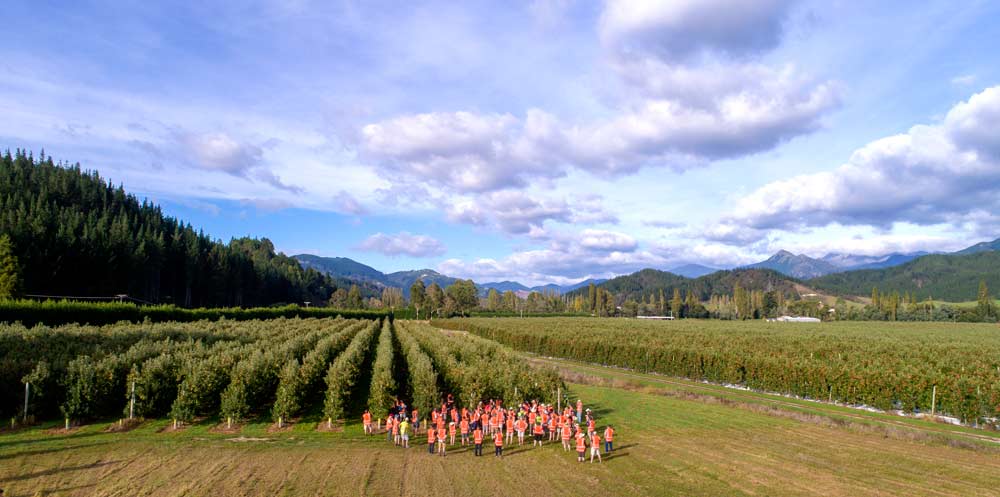
The view south through the Motueka Valley at Birdhurst Orchard in Nelson, New Zealand in February 2018. Below, the first group of International Fruit Tree Association New Zealand Study Tour attendees learns about how the Wilkins brothers transitioned the farm from cattle and tobacco to 500 acres of Gala, Jazz and Braeburn apples. (TJ Mullinax/Good Fruit Grower)
To those who’ve never been there, New Zealand brings to mind acclaimed movies — the Lord of the Rings and Hobbit trilogies — or perhaps the national bird and symbol, the kiwi, a nickname also applied to a native New Zealander.
Tourists might learn the country has three national languages: English, New Zealand sign language and Māori (pronounced MOW-ree), the language of the country’s indigenous population.
Maybe they’ll take in the island nation’s diverse geography, with spectacular mountain peaks, including the range known as the Southern Alps running along the country’s western half, and 9,300 miles of coastline that offer a range of outdoor activities.
Tourism is one of the nation’s biggest industries, drawing three-fourths as many people as live there — some 3.5 million tourists visited the country of just 4.7 million people in 2017.
Tourism, however, isn’t New Zealand’s top industry. Rather, that honor belongs to agriculture, and when it comes to horticulture, fruit is king.
In 2016, kiwifruit accounted for $1.67 billion in agricultural exports, followed by wine at $1.56 billion and apples at $692 million, according to Plant and Food Research, a New Zealand horticultural science research institute.
Apple exports alone grew 23 percent that year, which makes it no surprise that New Zealand hosted the International Fruit Tree Association in February and March.
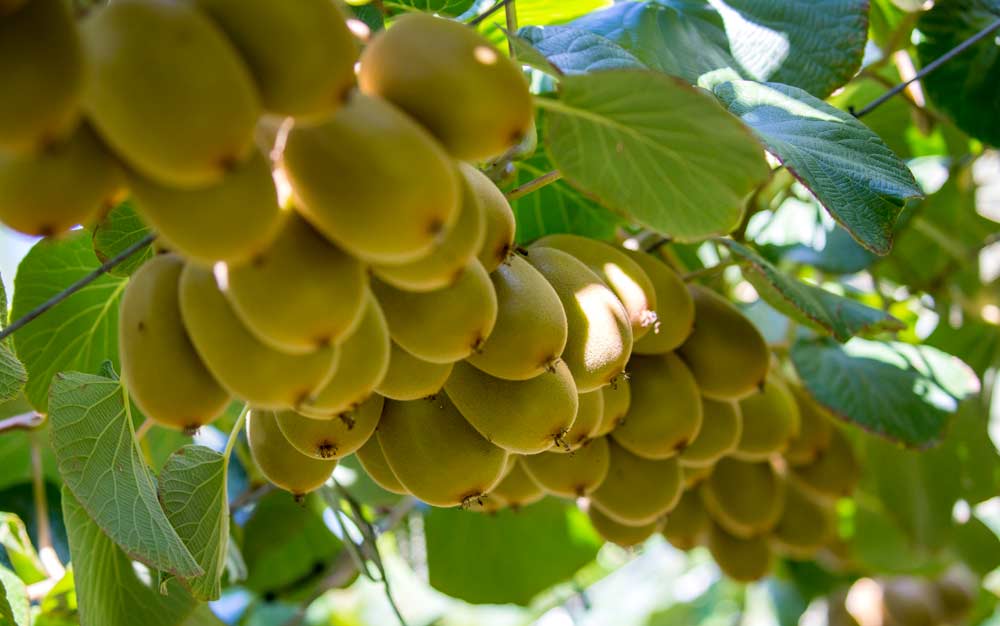
New Zealand’s most recognized fruit, Kiwi, growing at Waima Orchard in Hawke’s Bay in February of 2018. (TJ Mullinax/Good Fruit Grower)
The country also has become synonymous with new varieties, among them Royal Gala, Braeburn, Jazz and Envy, and is expanding its once-small foothold in the Asian export market.
“Obviously, there’s more to New Zealand than apple growing,” said Craig Hornblow, a horticultural consultant for AgFirst in the South Island’s Nelson area. “The thing you’ll find about New Zealand is that New Zealand has a little bit of everything, and you’re only about two hours from any of it.”
By comparison, a person could drive six hours just across Washington state’s Columbia Basin.
“That’s a big deal. We’re all just so close, so small, so coastal,” he said. “When you’re within a driving distance, it’s almost like these clusters of people have their orchard systems and their coffee groups — it’s sort of like their culture in each region, and it’s their stamp on the whole thing, and they’re all different.”
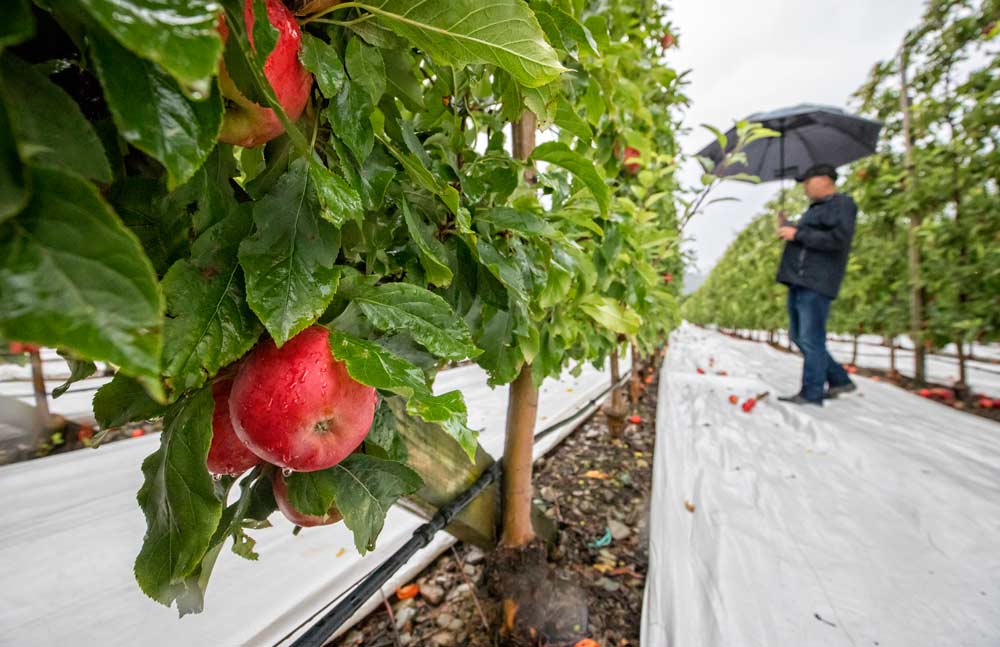
Craig Hornblow, at right, looks over a Royal Gala block scheduled for harvest the next day at Hoddy’s Orchard in the Nelson area in February 2018. Royal Gala is one of New Zealand’s most prolific new variety grown. (TJ Mullinax/Good Fruit Grower)
Snapshots of New Zealand
Five key growing areas comprise the bulk of New Zealand’s acreage planted in apples, interspersed among the valleys and rolling green hills of sheep and cattle:

Paul Paynter
—Hawke’s Bay on the North Island leads the way at 5,115 hectares (1 hectare is a little less than 2.5 acres), representing about 60 percent of the industry.
With very deep, alluvial, fertile soils, high light intensity, a long growing season and abundant water, it’s an easier place than others to grow successfully.
The downside? “Too much vigor,” said Paul Paynter, the fifth generation of his farming family who, along with his father, John, grows and packs apples and stone fruit under the Yummy brand.
“It’s a long growing season, and you have all this nitrogen that you can’t make go away. You let laterals run, they go 5 feet and you have 3 feet of blind wood. Excess vigor is something we’re really battling.”
—The Tasman/Nelson region at the northern tip of South Island represents a quarter to a third of the industry.
It features the most moderate climate of New Zealand’s growing regions; facing due north, the Nelson area collects more moisture, often more than 40 inches a year, but when the rains arrive isn’t necessarily as consistent as it used to be.
(Hornblow noted the area’s wet winter in August and September, followed by no rain from October to the first of January and by imposed water restrictions. Then, some 18 inches of rain fell over the next two months. “What’s usual? That’s not a word we use around climate here these days,” he said.)
Soils, meanwhile, range from stony riverbeds and heavy silt to old moraine soils and clay hills, creating highly variable growing conditions.
—Central Otago is a longstanding agricultural region in southeastern New Zealand’s South Island, known for cherries, apples and wine grapes, with narrow valleys and big dry hills, flanked by snow-capped mountains. The region is more likely to experience a winter freeze and frost in the spring, as well as hot summers, yet has seen a surge of new plantings in recent years.
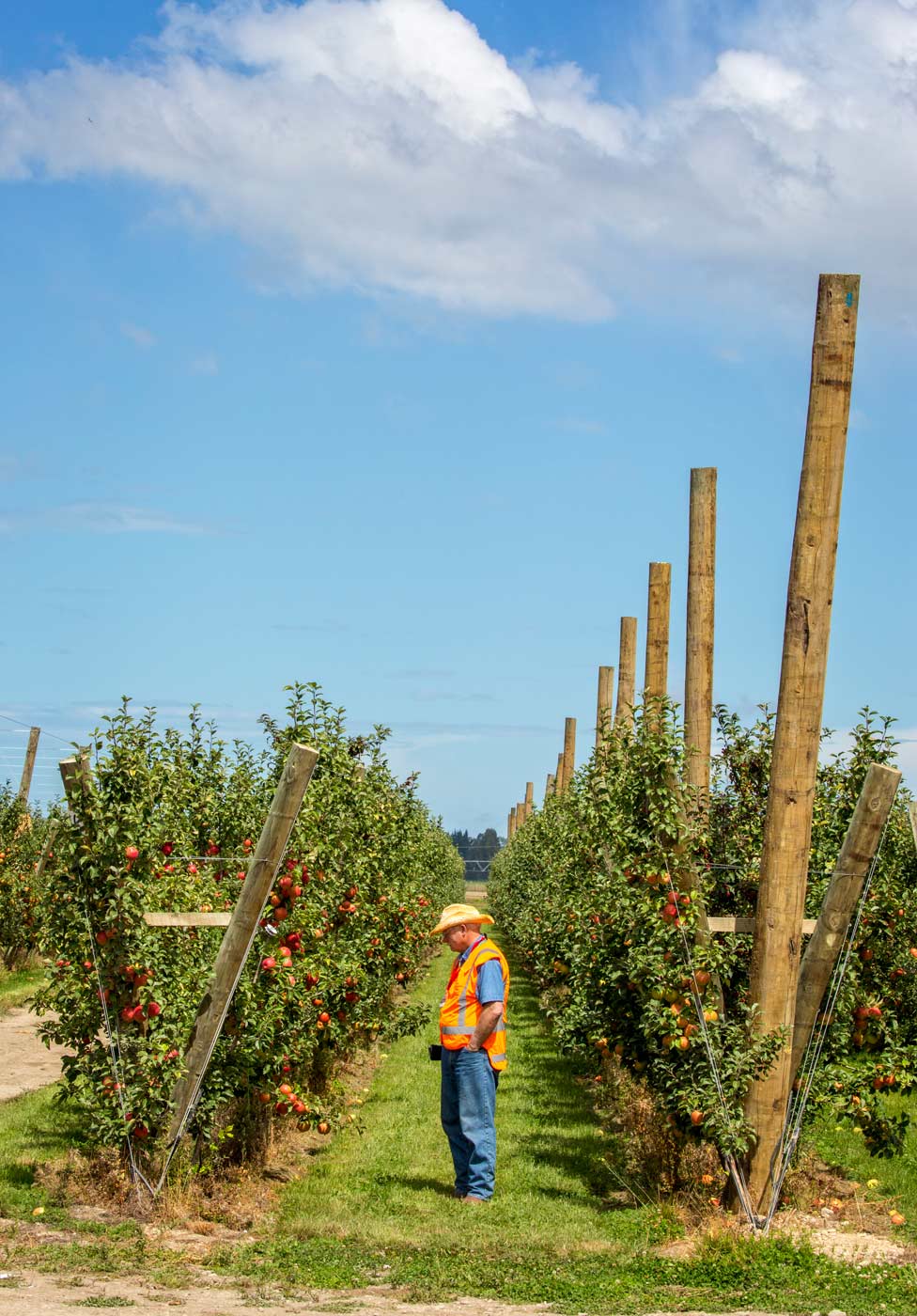
Matt Moser, a 2018 IFTA New Zealand Study Tour attendee looks over a young Honeycrisp block in the Timaru area in February 2018. The region was sought out for growing the variety because of its favorable climate for the fruit. (TJ Mullinax/Good Fruit Grower)
—Canterbury (including Timaru), south of the city of Christchurch on the South Island and another longtime agricultural region, known for cattle and row crops, is an area ripe for tree fruit expansion, with an excellent water supply, fertile soils and a close port, according to nurseryman Andrew McGrath.
“We have the right ingredients,” he said. “We believe the fruit industry is going to grow in that area. And on top of that, we’ve found uniquely that Honeycrisp grows well there.” (See “Honeycrisp in Timaru – Video”).
Many believe fruit growing in New Zealand will be pushed farther south over the next 50 to 100 years thanks to climate change, he said, adding “we think Timaru is a good bet.” Lack of infrastructure currently poses a challenge, with fruit being packed far to the north.
—Waikato and Gisborne, closer to the largest population center of Auckland, round out the country’s top producing regions.
Overall, total planted apple acreage in New Zealand has fallen 4 percent since 2007, as more growers turned to wine grapes and, more recently, kiwifruit, but new varieties on highly uniform systems are increasingly becoming the norm for new plantings, much like other leading apple-growing regions of the world.
Varieties and exports

Most of New Zealand’s apple and pear crop is shipped out of country through several ports in the North and South Island, such as Lyttelton Port of Christchurch in the South Island in February 2018. (TJ Mullinax/Good Fruit Grower)
Given that sheep outnumber people six to one in New Zealand, agricultural producers are tasked with finding export markets for all they produce — some 90 percent of the apples grown there are exported — and the country sits on the other side of the planet from most everyone.
That means growing apples that people in export markets want, and for New Zealand, has resulted in significant investment in new variety development over the past three decades.
Gala. Braeburn. Royal Gala. Envy. Jazz. The Pacific Series.
Over time, new varieties have replaced older varieties, such as Red Delicious, and growers are focused on producing top-grade fruit for the premium export market.
Asian markets are among the fastest-growing targets, and maintaining market access is key to growers’ overall success, which makes phytosanitary issues a top concern.

An example of how some New Zealand market their varieties to consumers. (TJ Mullinax/Good Fruit Grower)
Producing high-quality fruit, premium branding and strong marketing stories are paramount to growers who depend on exports to a premium market.
“All of those things needs to be part of the picture for us, and our reputation. Our markets are so far away,” Hornblow said. “The new variety market and breeding creates a point of difference for us. Hopefully, people see New Zealand as, ‘Hey, these guys can do this,’ thanks to our history.” •
Kia ora
Often used as an informal hello in New Zealand, kia ora is a Māori phrase that loosely translates to “be well and happy” or “life and health.” So, kia ora, as you read up on a few facts about the country…
—New Zealand is an island nation comprising two main islands — and around 600 smaller islands — in the southwestern Pacific Ocean, about 900 miles east of Australia across the Tasman Sea.
—Known for its varied topography created by the tectonic uplift of land and volcanic eruptions, the country ranges from coastal beaches and agricultural plains to sharp mountain peaks. Its total area covers some 103,000 square miles, slightly smaller than the U.S. state of Colorado.
—The total population in New Zealand is just 4.7 million people, compared to 7.3 million for Washington state. The most populous city is Auckland, while the capital city is Wellington.
—The tallest mountain in New Zealand is Mount Cook at 3,724 meters or 12,218 feet. By contrast, Mount Rainier in Washington state is 14,417 feet.
‘Number 8 wire’
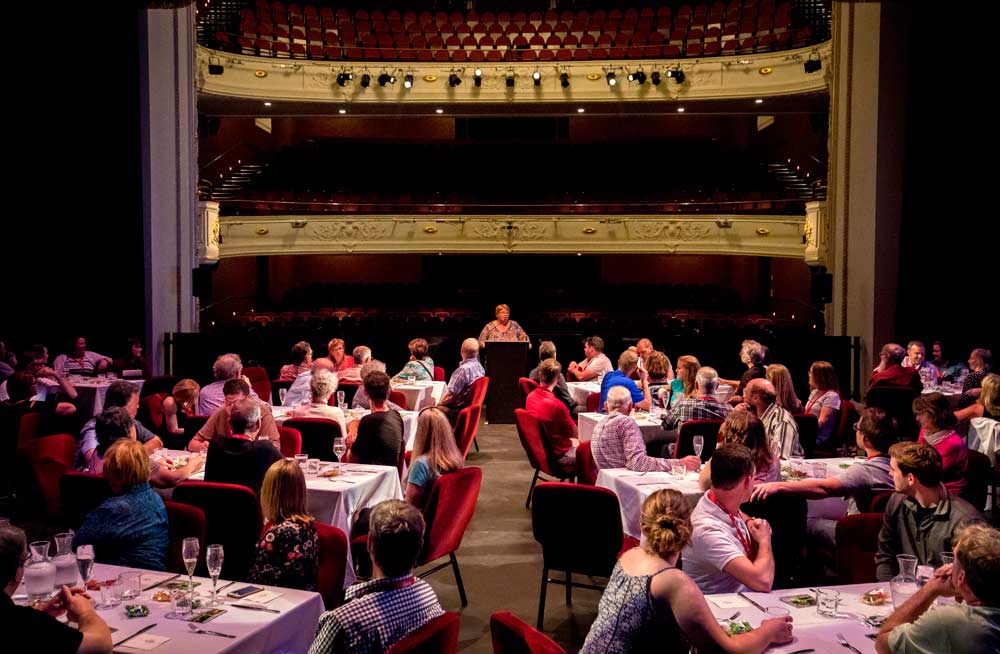
Karen Lewis talks to the first group of attendees of the 2018 International Fruit Tree Association New Zealand Study Tour at the Isaac Theatre Royal in Christchurch in February. (TJ Mullinax/Good Fruit Grower)
AgFirst horticultural consultant Yvette Jones offered a New Zealand welcome during the IFTA opening dinner, with a few pearls of wisdom about the nation’s culture.
“Number 8 wire is a British gauge of steel wire that was popularized as fencing wire around New Zealand farms in the 19th century. Not long after, farmers were using this wire as an unconventional shed tool for all kinds of practical purposes.
“New Zealand really is in the middle of nowhere,” she said. “Born out of isolation, Kiwis were improvising and adapting limited resources to produce innovative solutions. This ‘make do, can do’ attitude embodies the tradition of Kiwi ingenuity where New Zealanders refuse to be constrained by limited experience and resources and believe in their ability to solve problems and objectives that challenge the status quo.
“The ‘Number 8 wire’ mindset is everywhere you look in New Zealand primary industries,” she said, citing the nation’s crowd-funded plant research and breeding facility and revitalization of the New Zealand Pipfruit industry. “These innovative stories are the foundation of our country’s success.”
‘The land of the long white cloud’

The 2018 International Fruit Tree Association New Zealand Study Tour visits Te Mata Peak in February, overlooking many of Hawke’s Bay vineyards and tree fruit farms. (TJ Mullinax/Good Fruit Grower)
AgFirst horticultural consultant Yvette Jones offered a New Zealand welcome during the IFTA opening dinner, including a bit of history about the indigenous population know as the Māori, who call New Zealand Aotearoa or “the land of the long white cloud.”
Here’s a snippet from her speech:
“Māui a Polynesian demigod dreamed of the day that he could impress his brothers fishing. Secretly, Māui hatched a plan to prove he was a great fisherman. One night when Māui was alone, he began weaving a strong fishing line from flax. As he wove, he recited an old karakia, or prayer, to give his fishing line strength.
When he was finished, Māui took a whale jawbone, which his ancestor had given him, and bound it securely to the line. Early the next morning Māui took his line and hid in his brother’s canoe as they went fishing.
Māui emerged and stood at the front of the canoe and spun his line out to sea; the line sunk deep to the ocean floor, down into the depths of the domain of Tangaroa, the god of the ocean. Instantly the hook was taken. Māui held tight to his line and slowly a giant fish was pulled to the surface.
When Māui went back to tell his people of the achievement, his brothers began chopping greedily at the huge fish, claiming huge pieces of it as their own. As Māui and his people returned, they saw how greedy the brothers had been. They were so greedy that they had chopped huge gullies and mountains from the fish’s flesh.
Over many hundreds and thousands of years, these gullies and mountains became part of the landscape of Aotearoa as we know it today. Birds, plants, animals and the people of the islands populated the giant fish of Māui. And in time, Māui’s giant fish became known as the North Island of Aotearoa, and Māui’s canoe the South Island.”
—by Shannon Dininny / photos by TJ Mullinax






Leave A Comment